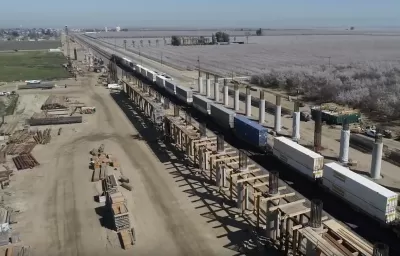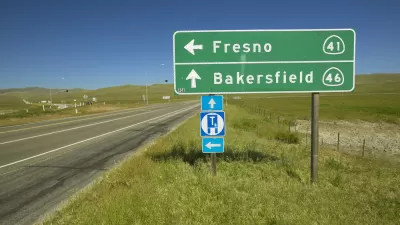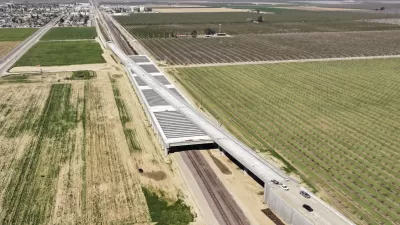A newly restructured leadership promises to speed up the arduous construction process and start running trains in five to eight years.

After a restructuring of the authority’s leadership, the California High-Speed Rail Authority (CHSRA) says it plans to begin running trains in five to eight years, reports Skip Descant in GovTech.
As Descant explains, “The 494-mile project to connect San Francisco and Los Angeles with trains traveling up to 220 mph has been hobbled by complications ranging from land acquisition to utility relocation to funding to political opposition, since voters approved a bond measure that paid for it in 2008.”
There are currently 171 miles of rail line under construction between Merced and Bakersfield in the Central Valley. According to the CHSRA, “Up to 24 stations will be constructed and the project will soon begin the phase of laying track and erecting the overhead catenary system of wires supplying electricity.”
The project will eventually connect to Palmdale, a desert community north of Los Angeles and a hub for the regional Metrolink train, in the south and to Gilroy, a town south of San Francisco with a Caltrain station, in the north.
FULL STORY: Restructured Calif. High-Speed Rail Is Poised to Lay Track

Study: Maui’s Plan to Convert Vacation Rentals to Long-Term Housing Could Cause Nearly $1 Billion Economic Loss
The plan would reduce visitor accommodation by 25,% resulting in 1,900 jobs lost.

North Texas Transit Leaders Tout Benefits of TOD for Growing Region
At a summit focused on transit-oriented development, policymakers discussed how North Texas’ expanded light rail system can serve as a tool for economic growth.

Using Old Oil and Gas Wells for Green Energy Storage
Penn State researchers have found that repurposing abandoned oil and gas wells for geothermal-assisted compressed-air energy storage can boost efficiency, reduce environmental risks, and support clean energy and job transitions.

Private Donations Propel Early Restoration of Palisades Playground
Los Angeles has secured over $1.3 million in private funding to restore the Pacific Palisades playground months ahead of schedule, creating a modern, accessible space that supports community healing after recent wildfires.

From Blight to Benefit: Early Results From California’s Equitable Cleanup Program
The Equitable Community Revitalization Grant (ECRG) program is reshaping brownfield redevelopment by prioritizing projects in low-income and environmental justice communities, emphasizing equity, transparency, and community benefits.

Planting Relief: Tackling Las Vegas Heat One Tree at a Time
Nevada Plants, a Las Vegas-based nonprofit, is combating the city’s extreme urban heat by giving away trees to residents in underserved neighborhoods, promoting shade, sustainability, and community health.
Urban Design for Planners 1: Software Tools
This six-course series explores essential urban design concepts using open source software and equips planners with the tools they need to participate fully in the urban design process.
Planning for Universal Design
Learn the tools for implementing Universal Design in planning regulations.
Ascent Environmental
Borough of Carlisle
Institute for Housing and Urban Development Studies (IHS)
City of Grandview
Harvard GSD Executive Education
Toledo-Lucas County Plan Commissions
Salt Lake City
NYU Wagner Graduate School of Public Service





























